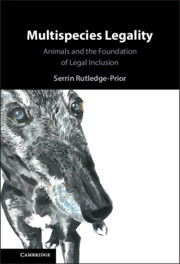Refine search
Actions for selected content:
142 results
Chapter 3 - Shapes of Integration
- from Part I - Historiography
-
- Book:
- Shapes in Revolution
- Published online:
- 07 November 2025
- Print publication:
- 20 November 2025, pp 60-97
-
- Chapter
- Export citation
Introduction
-
- Book:
- Making Medical Progress
- Published online:
- 12 December 2025
- Print publication:
- 20 November 2025, pp 1-33
-
- Chapter
-
- You have access
- Open access
- HTML
- Export citation
Chapter 5 - Litanies, Food and Personhood
- from Part II - Ethnography
-
- Book:
- Shapes in Revolution
- Published online:
- 07 November 2025
- Print publication:
- 20 November 2025, pp 139-169
-
- Chapter
- Export citation
15 - Dying and an Afterlife
- from Part III - Lifespan Development in Diverse Sociocultural Contexts
-
-
- Book:
- The Cambridge Handbook of Psychological Anthropology
- Published online:
- 22 October 2025
- Print publication:
- 25 September 2025, pp 367-386
-
- Chapter
- Export citation
8 - Person-Centered Ethnography
- from Part II - Methodological Innovations
-
-
- Book:
- The Cambridge Handbook of Psychological Anthropology
- Published online:
- 22 October 2025
- Print publication:
- 25 September 2025, pp 201-221
-
- Chapter
- Export citation
6 - Too Much, Too Little, Too Unlikely
-
- Book:
- Multispecies Legality
- Published online:
- 18 June 2025
- Print publication:
- 21 August 2025, pp 129-148
-
- Chapter
- Export citation
Conclusion
-
- Book:
- Multispecies Legality
- Published online:
- 18 June 2025
- Print publication:
- 21 August 2025, pp 167-172
-
- Chapter
- Export citation
3 - Unnecessary, Inconsistent, and Exclusionary
-
- Book:
- Multispecies Legality
- Published online:
- 18 June 2025
- Print publication:
- 21 August 2025, pp 60-88
-
- Chapter
- Export citation
Capitalism and the Semiotics of Corporate Personhood in a Law of Human Persons
-
- Journal:
- Signs and Society / Volume 13 / Issue 3 / September 2025
- Published online by Cambridge University Press:
- 15 August 2025, pp. 355-376
-
- Article
-
- You have access
- Open access
- HTML
- Export citation
2 - The Real Person Approach
- from Part II - Paradigm and Principle
-
- Book:
- The Boundaries of Blame
- Published online:
- 26 July 2025
- Print publication:
- 14 August 2025, pp 49-78
-
- Chapter
- Export citation
Editorial - Property Rights through Theory and Practice
-
- Journal:
- Asian Journal of Law and Society / Volume 12 / Issue 3 / September 2025
- Published online by Cambridge University Press:
- 11 August 2025, pp. 305-307
-
- Article
-
- You have access
- HTML
- Export citation
Chapter 11 - ‘Everyone has a price at which he sells himself’
- from Part III - Human Feeling and Ethical Development
-
-
- Book:
- Kant and Stoic Ethics
- Published online:
- 18 July 2025
- Print publication:
- 07 August 2025, pp 187-205
-
- Chapter
- Export citation
Chapter 6 - The Preschooler
- from Part II - The Growth of Meaning
-
- Book:
- The Development and Organization of Meaning
- Published online:
- 11 June 2025
- Print publication:
- 26 June 2025, pp 67-84
-
- Chapter
- Export citation

Multispecies Legality
- Animals and the Foundation of Legal Inclusion
-
- Published online:
- 18 June 2025
- Print publication:
- 21 August 2025
35 - Cross-Cultural Perceptions of Rights for Future Generations
- from Part III - Applications
-
-
- Book:
- The Cambridge Handbook of Experimental Jurisprudence
- Published online:
- 17 May 2025
- Print publication:
- 05 June 2025, pp 610-648
-
- Chapter
- Export citation
“We Share an Unbreakable Bond:” Sociality and Language Ideologies in Human Relationships with Artificial Intelligence
-
- Journal:
- Signs and Society / Volume 13 / Issue 2 / June 2025
- Published online by Cambridge University Press:
- 16 May 2025, pp. 290-310
-
- Article
-
- You have access
- Open access
- HTML
- Export citation
Building dignity at the bedside: A reflective clinical model for clinical encounters
-
- Journal:
- Palliative & Supportive Care / Volume 23 / 2025
- Published online by Cambridge University Press:
- 22 April 2025, e94
-
- Article
-
- You have access
- Open access
- HTML
- Export citation
“The wife is the mother of the husband”: Marriage, Crisis, and (Re)Generation in Botswana’s Pandemic Times
-
- Journal:
- Comparative Studies in Society and History / Volume 67 / Issue 3 / July 2025
- Published online by Cambridge University Press:
- 24 March 2025, pp. 524-546
-
- Article
-
- You have access
- Open access
- HTML
- Export citation
Chapter 1 - The Liberal Tradition and Slavery
- from Part I - Concepts
-
-
- Book:
- The Cambridge Companion to Nineteenth-Century American Literature and Politics
- Published online:
- 06 March 2025
- Print publication:
- 13 March 2025, pp 19-34
-
- Chapter
- Export citation
1 - Of Hearts, Visions, and Pentecostal Subjects
- from Part I - Urban Youth and Pentecostal Worlds
-
- Book:
- Youth, Pentecostalism, and Popular Music in Rwanda
- Published online:
- 19 December 2024
- Print publication:
- 02 January 2025, pp 35-65
-
- Chapter
- Export citation
